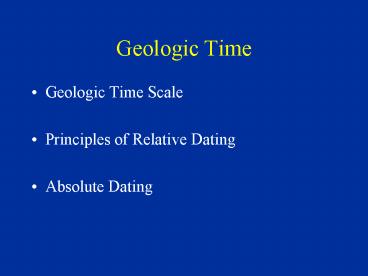Geologic Time - PowerPoint PPT Presentation
1 / 28
Title:
Geologic Time
Description:
Defined as eons, eras, periods, and epochs. Each eon, era, etc... usually relates to significant ... In a series of sedimentary rocks younger rocks are ... – PowerPoint PPT presentation
Number of Views:51
Avg rating:3.0/5.0
Title: Geologic Time
1
Geologic Time
- Geologic Time Scale
- Principles of Relative Dating
- Absolute Dating
2
The Geologic Time Scale
- Defined as eons, eras, periods, and epochs
- Each eon, era, etc usually relates to
significant changes in the fossil record
3
(No Transcript)
4
Some Basic Geologic Principles
- Law of Superposition
- Principle of Original Horizontality
- Principle of Cross-Cutting Relationships
5
Law of Superposition
- In a series of sedimentary rocks younger rocks
are laid on top of older rocks - e.g. Grand Canyon, as you hike up and out, rocks
are progressively younger
6
Law of Original Horizontality
- Sedimentary rocks are laid originally in a
horizontal (lying flat) manner - Rock beds that are no longer horizontal have been
tilted
7
Cross-cutting relationships
- What came first?
8
Unconformities
- Interruptions of the geologic record
B
A
9
N
M
L
K
J
I
H
G
F
E
O
D
B
C
A
10
Correlating Rock Layers
- Rock formations are sometimes unique enough to
identify in multiple places - This allows for a larger series of rock units to
be related
11
(No Transcript)
12
Fossils
- We know the progression of life as it evolved on
earth through time - Certain fossils occur only during limited time
periods
13
540-240 Million years old
Trilobites (bottom dwelling critters) -
Paleozoic Dinosaurs - Mesozoic Mammals - Cenozoic
240-65 Million years old
65 Million years old to present
14
Planetary Surfaces
- If we only have pictures, how do we date
planetary surfaces?? - Superposition and cross-cutting relationships
- Crater density
15
C
4
D
2
A
1
B
3
16
Absolute Dating
- Radiometric Dating
- Based on radioactive decay of atoms (isotopes)
- Most common and reliable method of dating
- Also paleomagnetism, tree rings, etc
17
Radioactive Decay
- Some elements nuclei have a tendency to
spontaneously break apart - This occurs with certain isotopes
- e.g. U238, Rb87, K40, C14
18
(No Transcript)
19
Radioactive Decay
- Radioactive decay converts mass into energy
(emc2) - This is why the Earths interior is hot
- Radioactive decay happens at a very constant and
predictable rate
20
Where Does Helium Come From??
- Helium is used for balloons and blimps
- So where can we find helium??
- Alpha particles (2 neutrons and 2 protons) are
helium atoms released in nuclear fission - 238U ? 234Th 4H
- Geologists find helium much in the same way they
find oil and natural gas
21
Half Life
- The half life of a radioactive element is the
amount of time it takes for half of the original
amount of material to decay
22
C14
N14
It takes 5730 years for half of the original
carbon-14 to decay to nitrogen-14
23
Radiometric Dating
- Measure ratio of parent to daughter elements
(isotopes) to determine crystallization age - Absolute age is dependent on both the ratio of
parent to daughter elements and half life
24
(No Transcript)
25
How Old is It?
- Half life of 1 billion years Parent isotope is
K40, daughter is Ar40
Ratio of K40 to Ar40 Age
½ to ½ ¼ to ¾ 1 to 0 1/16 to 15/16
1 Billion years
2 Billion years
0 years
4 Billion years
26
Elements used for Geologic Dating
27
Caveats
- Works mostly on igneous rocks
- Records the date of crystallization
(solidification), not deposition - Metamorphic and sedimentary rocks are much more
difficult to date
28
How Old is It?
Limestone layer is between 200,000 and 400,000
years old.































